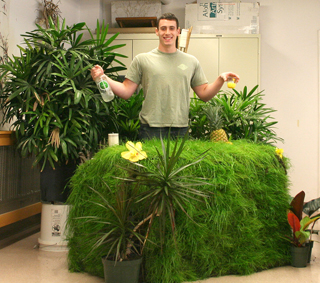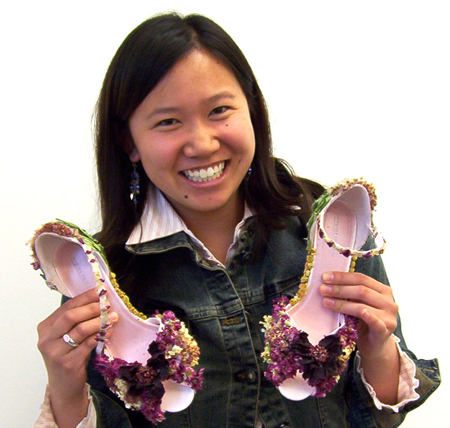Human Flower Project
Wednesday, December 12, 2007
Horticulture 201—Learning to Leap
Marcia Eames-Sheavly’s innovative course in art and horticulture may only look like an elective.

Cornell student Zach Aburahma and his tiki bar
class project for Horticulture 201
Photo: Courtesy of Marcia Eames-Sheavly
In our overlong stay at school, interdisciplinary research was a lot like motherhood: much extolled but hardly respected. We’ll leave the defense of motherhood to those better qualified. But we can and do endorse mixing up fields of study. Psychology and botany, cooking and philosophy, poetry and math, dentistry and military history (Really – If a face can launch a thousand ships, how many battalions might aching jaws have conscripted?)
Marcia Eames-Sheavly at Cornell University has been mixing it up for years now with a popular undergraduate course that’s also a human flower project: The Art of Horticulture. (Many thanks to our compadre Craig Cramer of Ellis Hollow—and Cornell U.— for the spark.)
Marcia is a member of the horticulture faculty who’s at ease drawing and contemplating plants as well as growing them. In her Fall 2007 syllabus, she calls this course “a unique chance to view the world of plants from a very different perspective—an important one, given that observation and creativity are cornerstones of advancement in science.” For those of us knocked in the head with two other cornerstones—control and measurement—this approach to science brings out the sun.
Horticulture 201 invites all comers. In the semester just over, the class included, “a horticulture major, a handful of natural resource majors, some hotel school students, some art students, engineering…,” Marcia writes. For the most part, those differences don’t surface, she says, except when “we’re grafting, or doing something that is more horticultural—then the hort students might jump in to assist others.”
Students select readings from an eclectic list of titles – including Michael Pollan’s The Botany of Desire, Amy Stewart’s Flower Confidential, and David Masumoto’s Epitaph for a Peach, But two less orthodox assignments are central to the class—the keeping of a journal all semester long and a final project demonstrating the connection between horticulture and art. It’s with these reflective and expressive elements that, in our mind, Horticulture 201 takes the leap. Yeah, Mother!
 Natural orchid sculpture, and its maker Chrissy Dykeman
Natural orchid sculpture, and its maker Chrissy Dykeman
for “The Art of Horticulture”
Fall 2007, Cornell Univ.
Photo: Marcia Eames-Sheavly
On the Hort 201 website, you can see many intriguing class projects past: a young woman sitting underneath a table, exploring “garden archetypes”; someone’s “turtle corral”; a young man proudly extending a scarf just dyed with indigo; “A Girl’s Life as Told in Flowers” (We’d be eager to read that); a very fine sod cow.
Throughout the semester, there are guided writing assignments. From the student journals, Marcia has graciously sent us these excerpts:
“The truth is that flowers speak many languages, hold many meanings, and, depending on the moment, the same variety can conjure up totally opposing feelings. In the best of times, I can see the face of God in them. In the worst of times, they remind me of my mortality.”
After a class on floral design, one student wrote:
“It’s interesting, after the labs on ikebana and floral arrangement, how the concept of beauty has evolved for me. In a world so driven by immediate gratification, most of us have come to view beautiful plants as only those bearing a dramatic flower bursting with color. But I have found that beauty is not just flower-deep; so many other parts of the plant can be used in so many creative ways, that the possibilities of creating something beautiful are endless.”
One writer found her conscience stung by the flowers provided in a design workshop. “While I fretted about the way in which the flowers had been grown (Organically? Sustainably?) and the conditions for workers (Were they fairly treated? Fairly paid? Exposed to chemical pesticides and herbicides?), I also battled the desire to have a giant, colorful ikebana, complete with giant southeast Asian ginger flowers. After much deliberation, I decided I wanted to create a display that would showcase plants we could find around town. I tried to pick items that looked like they could have been found locally (Ithaca, New York)—cattails, goldenrod flowers, and a few stones from the driveway. At the end, I was pleased with my display.”
Another assignment drew out a memoirist – descendant of William Wordsworth?
“My boyfriend and I drove by this huge field of orange tiger lilies every day that he picked me up, which was frequently. Every time we drove by I was fascinated by how colorful they were, and by the sheer volume of how many there were growing wild in this field. Then one day, when he came to pick me up, I got a huge pile of these flowers. Tiger lilies don’t last that long, and these were almost at the top of the hill, but they were still brilliant, and I got to think about the huge field of color whenever I looked at them.”
Interdisciplinary research, at least ten years ago, when we were breaking loose of the academy, had constantly to make a case for itself. Is this work publishable in a scholarly journal? Or will it lead to a tenure track job? Professor Eames-Sheavly tells us, “My sense is that the change is more internal and within students, less about which class comes next. By that I mean they often indicate, at semester’s end, in their journals, that through the course they have learned that they need reflective time in their lives, time to intentionally bring in opportunities for creativity, and that they want to continue journalling. They often talk about how they have discovered that engaging in the course activities, final projects and so forth, they have discovered that taking time to take a walk in a garden or to work on a painting actually refreshes them, and that they are more ready to finish that paper, or take that exam, than they would have been had they ground away at that paper all afternoon(!) What an important life discovery!”

Flowered shoes, by Bethany Tong, the Art of Horticulture, Fall 2007
Photo: Courtesy of Marcia Eames-Sheavly
And what an important time to make that discovery, Marcia. Idyllic as the college years might seem to those of us who’re pre- or post- or just non-academics, it’s not all whiff-n-poof on campus. May we turn back to science – psychiatry; it’s disclosing that more and more students are under strain. An article in Psychiatric News showed out of a survey of 16,000 college students (in 2000), 64% reported being “emotionally exhausted”; 38% reported they felt “so depressed it was difficult to function.”
What are college counselors recommending to help? A number of things, but among them are journaling, setting aside quiet time, and deepening one’s spiritual life – to this endless end, the University of Georgia’s Counseling Center specifically mentions gardening.
Professors and students – and whoever else would like to be “pleased with my display” – you may want to take a closer look at Marcia Eames-Sheavly’s syllabus. Whether you’re enrolled at Cornell or not, these assignments with their interdisciplinary arcs are efforts the best of times reward, and the worst of times demand.
Art & Media • Culture & Society • Medicine • Science • Permalink




